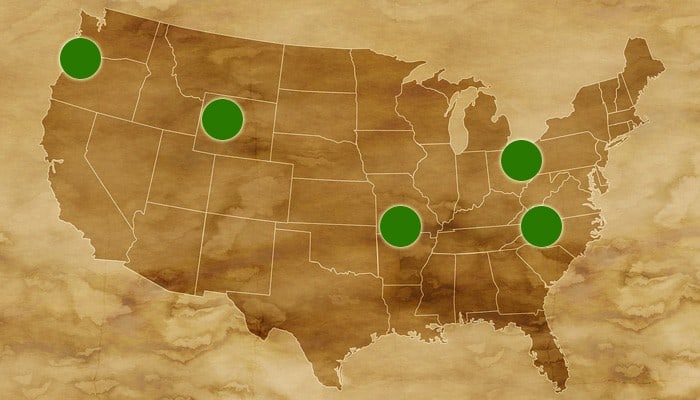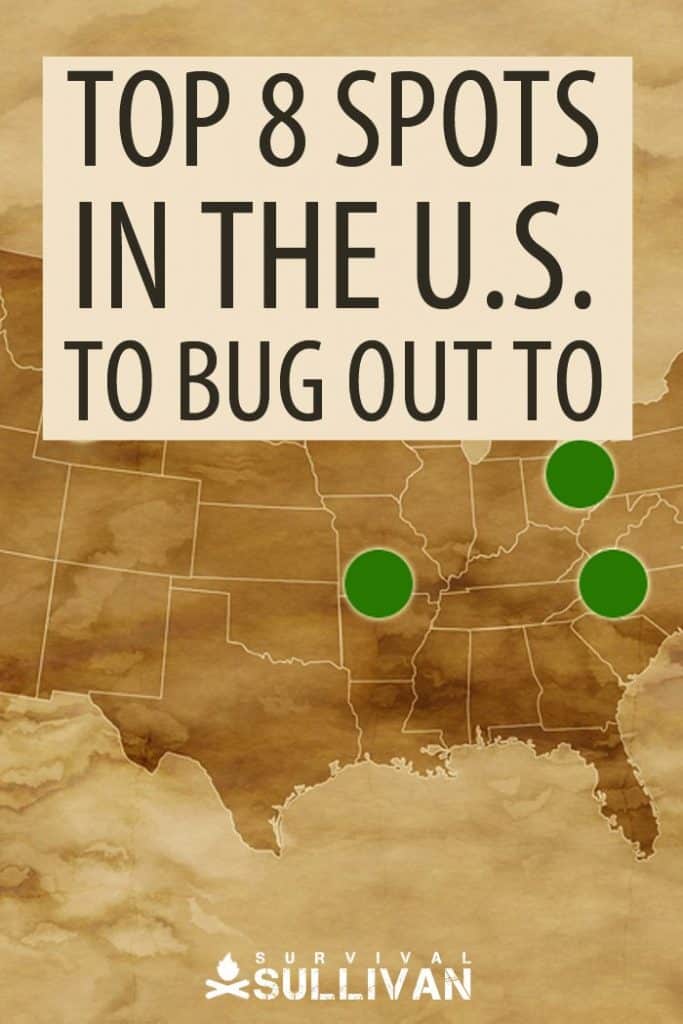When you plan a bug out strategy, the location is one of the most important considerations. I think some people plan to just grab their bug-out bag and start walking. That is a recipe for disaster.
To be successful you need to carefully plan a bug out location along with a route to get there. This means you need to live relatively close to this location. If the highways are clogged when SHTF, you may be walking to your bug out destination.

When selecting a location, there are a few priorities that need to be evaluated. One of the most important is accessibility. Can you get there?
If the location is too far away or on the other side of a natural barrier like a river or a cliff, you are going to have a hard time making it to safety.
I suggest you find a spot that is under 100 miles away and has a clear path to get you there.
On the other hand, you want this property to be inaccessible for other people. It needs to be hidden, so a location that is heavily wooded or one that has lots of ridges and valleys is ideal.
You will want this spot to be well off the grid, so miles from the closest road or trail. If you have geographic features that would block other people, that is even better.
Try finding a spot on a steep hillside or one that backs up to a river or bluff. If it is wooded then thick brush is a good deterrent. Of course you can always put up a fence, but natural barriers are even better.
The next priority is your ability to defend the location. If you have a crew trying to enter your camp and take your supplies, can you hold them off? Military strategy says the best option is high ground.
If you can find a tall ridge that is heavily wooded, that would allow you to view intruders from all sides. In addition, the steep terrain would slow down any intruders making them easy targets.
Another good option is putting your camp against any geological feature that protects your backside. If your camp backs up to a tall cliff side or even a cave, that prevents intruders from flanking you.
Another point of focus needs to be your proximity to large cities. There are several reasons that big cities are an issue. One is that the closer you are to a large city, the more likely you are to be overrun by occupants of that city.
Urban areas in particular have a high percentage of inhabitants lacking survival skills. These people are more likely to take supplies from those that are more prepared.
The other major concern is that large cities could be targets for attack. Any presence of enemy soldiers would be a concern, but the big issue is chemical, biological, or nuclear attacks.
Any of these scenarios could end up in your back yard if you are too close to the blast. Whether it is fallout, gas clouds, or infected victims, you do not want to be anywhere near an attack.
The weather trends in the area you select are important as well. An ideal setting would be an area having a temperate climate. If the weather gets too cold or drops several feet of snow in the winter, your location could be dangerous.
In addition to hypothermia and frostbite, just getting around would be an issue.
Extreme drought is a red flag as well. If your area is so dry that finding water or growing a garden is difficult, you should probably mark that spot off your list. Drought areas are also more prone to wildfires which could wipe out your camp.
Be wary of areas prone to natural disasters. Lowlands that are prone to flooding or coastal areas prone to hurricanes should be avoided.
Although hard to predict, you may want to shy away from areas prone to tornadoes or earthquakes. The odds of these disasters damaging your property are small, but still worth considering.
Areas that have a potential for a major disaster in the near future may be a bad idea.
For example, many scientists have predicted that the Yellowstone Caldera may erupt in the near future. This would wipe out the Pacific Northwest and send an ash cloud covering the entire western half of the United States.
Two other areas to be wary of are the San Andreas and New Madrid fault lines. These faults run along the entire west coast as well as along the Mississippi River.
Seismologists have hypothesized that there could be very destructive earthquakes in both areas in the near future. There is no way to accurately predict an earthquake, but there are signs that can be followed.
We can also look at damage from previous earthquakes in these areas to determine how bad it could be.
Finally, you should look at the natural resources available on the property. Sure you may have a stockpile of food and clean water, but that can always run out.
Look for areas that are heavy with game and fish. Try to find land with a natural spring or at least a clean creek. Focus on areas that have rich black soil for planting a garden.
Do not forget about fire wood either. Try to find an area with plenty of dead trees you can cut up for the fire.
Here are my rankings of the top areas in the US to bug out or to start a homestead retreat.
Ozark Mountains (MO, AR, OK)
Maybe it is because I grew up in this area, but I feel that it has everything you could need for a bug-out location.
This hilly area is thick with white pine and oak trees, and the woods are teeming with wildlife. I hunt in this area every year and I have yet to go a single day without seeing at least one deer.
The streams have trout, bass, and catfish along with all kinds of other wildlife. Natural springs are plentiful and there is an extensive array of limestone caves.
The soil is fairly rich and the climate is mild. You can have cold winters and hot summers, but nothing unbearable. The land is also inexpensive and sparsely populated.
The Ozarks do not have any major cities that would be targeted. These hills, forests, and caves make it easy to disappear.
You can hide your camp where nobody would find it, and the caves and bluffs can make it easy to defend if needed.
There are several areas that are miles from the closest road or trail. Also the gun and building permit laws are fairly loose in these areas.
There are only three minor downsides. The Ozark Mountains are somewhat close to the New Madrid fault line, but they are far enough away that damage would be minor.
There are some military bases in central Missouri, but they are far enough that they should not be major concern. You will occasionally get tornadoes in this area, but they typically damage an isolated area.
Appalachian Mountains (GA, TN, KY, VA, NC, WV)
These mountain areas are ideal for many of the same reasons that the Ozarks are ideal. This area consists of plenty of bluffs, caves, and springs.
It is heavily wooded and has an abundance of game in the forest and countless fish in the streams. Also the soil is typically rich and fertile.
Most of these states are lax on gun laws and building permits. However, certain parts of the Appalachians are close to large cities. You need to be selective about which sections of this mountain chain you consider.
If you are far enough into the wilderness, the land is cheap and easy to defend. It is also incredibly easy to stay hidden.
The weather is similar to the Ozarks, but the Appalachians have a greater potential for heavy snow as you move to higher elevations.
There are a few downsides to this area. The proximity to major cities could mean issues with foreign attacks or looters invading your property. The potential for heavy snow makes it a bit more difficult to get around.
Certain parts of this area are close to the New Madrid fault line. The key to bugging out in the Appalachian Mountains is to find the right spot. The more remote, the better.
Rocky Mountains (CO, WY, MT)
The Rockies may be the most remote location in the lower 48 states. There are areas that are so remote that they have never been explored.
You can travel dozens of miles in the Rockies without crossing any roads or trails. There is also a heavy population of elk, so you have the potential to feed your family for months with one hunt.
This area is pristine and has plenty of game animals and fish. Huge salmon and trout can be caught in the streams and provide a great food source.
There are an abundance of springs and clean rivers. In lower elevations the soil is rich, but it gets rocky as you increase in elevation. The weather is ideal except for during the winter.
In this area the land is inexpensive. The laws on guns and building permits are pretty flexible. The jagged mountains and dense forests make it easy to vanish and also easy to defend your location.
There are not many major cities to worry about in this area. Just steer clear of Denver and you are fine.
There are some major issues with this location. The winter weather is horrible. It is not uncommon for people hunting at high elevation to get stranded by unexpected snow storms.
The temperatures are low and the snow can come down by the foot. Also there are some military installments in the area that could be targeted.
Finally, predators can be a concern in certain portions of these mountains. Bears, wolves, and mountain lions mean that you are not at the top of the food chain.
Pacific Northwest (ID, WA, OR)
If you want to vanish off the face of the earth, what better spot than bigfoot country? In the lush rainforests of the Pacific Northwest you will find an abundance of wildlife and rich black soil. There is an ample supply of clean drinking water year round.
If you need to keep your camp hidden, the dense forests of this area are ideal. Some parts of this region are hilly and easy to defend, while others are flat and harder to defend. There are also several large cities in this area, so staying hidden is even more important.
Aside from the dense population in certain areas, there are other issues with this location. In parts of the Pacific Northwest it rains constantly. In others you will find a desert like climate that gets almost no rain.
The snowfall in winter can get pretty intense and the temperature drops well below a comfortable point. You would also be very close to the Yellowstone Caldera, so the entire area could be wiped out at some point.
Probably the two biggest concerns are the laws and the land cost. Land can be very expensive in this region, so you will have to try to find a deal.
In addition, this area has become flooded by liberal politicians in recent years. They are making prepping and survival much more difficult with the laws they have passed.
Honorable Mentions
The Dakotas could be considered a good area, but the winters are rough and the land is flat. It can be hard to hide or defend a camp. There are also several military installments that could be targeted.
Central Alaska is a survivalist’s dream location, but it is so remote and harsh that most people would not survive. Between the negative temperatures and the bears, this area is awfully dangerous for a bugout spot.
Northern Maine is a great location. There are dense forests filled with Moose and other wildlife, but it is fairly close to Boston, NYC, and other major cities. That whole area could be targeted by another country.
Texas has areas that could make for a good bug-out location, but most of it is dry and flat making it hard to defend. It also borders Mexico which brings along its own challenges.
Final Word
So, where are you thinking to move or bug out to? Is it on this list? If you already live in one of the locations mentioned, will you help your fellow preppers out by letting us know it’s a good idea to come to your region?


My name is Ryan Dotson and I am a survivalist, prepper, writer, and photographer. I grew up in the Ozark Mountains and in the foothills of the Pocono Mountains. My interest in survival started when I was in Boy Scouts and continued as my father, uncle, and grandfather taught me to hunt and fish. In the last few years I have started taking on survival challenges and have started writing about my experiences. I currently live in Mid-Missouri with my wife Lauren and three year old son Andrew.

I live in SW LA which is closer to the Texas border. We do have mosquitoes and hurricanes and flooding, but it’s so warm and wet here you can grow just about anything. There’s a lot of pasture land and land and price of living is cheap.
If one was to have LA as a bug out location you’d have to make sure you had lots of mosquito repellent and light mosquito repellent clothing. There are alligators which are the biggest natural predator problem. They roam golf courses here! Doing some research on old plantation life would be helpful in figuring out how to keep cool. That’s probably the biggest challenge. By 9am in the summer, you’re sweating. And I’m the winter it’s a damp cold so having the proper clothing and heating is key.
I live in the N.Ga. mtns and have been in the survivalist mind set for most of my life. Taught early how to live and hunt, fish and grow my food. Sister lives in Wilderness section in Chattahoochee Nat. Forest with 14 acres, 2 flowing springs and game. Fires are the huge concern here.
Skipped NJ completely, but not surprising. However, there are great places not too far away, both in North and Southwestern NJ. Glad they weren’t published.
New Jersey Ranks dead last as the worst place to live when the SHTF. NJ has Extremely high Taxes, High Cost Of Living, High Population Density, several Nuclear Reactors, a large number of Military Bases that would be targeting in a military conflict. This list goes on and on.
I built a application to help to organize this data and allow people to find a bug out location that meets their needs. It provides data about Demographics, Taxes, Cost of Living, Food Production, Bio/Nuclear Hazards, Military Targets, Self Defense, Weather Events for each State in the US.
If you interested in this type data you may find the Location Risk Assessment Tool (LRAT) helpful.
https://www.microsoft.com/en-us/p/location-risk-assessment-tool/9pg246xnss1b?activetab=pivot:overviewtab#
Any comments on Upper Michigan / northeast Wisconsin? Cold but water and woods.
Texas is NOT all flat. Ever been to the Hill Country? West Texas?
Ozarks 💯✔️